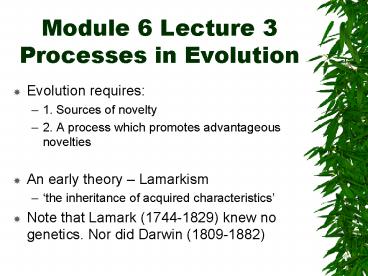Module 6 Lecture 3 Processes in Evolution - PowerPoint PPT Presentation
1 / 15
Title:
Module 6 Lecture 3 Processes in Evolution
Description:
the inheritance of acquired characteristics' Note that Lamark (1744-1829) ... event and more often produces neutral or deleterious mutants as beneficial ones. ... – PowerPoint PPT presentation
Number of Views:50
Avg rating:3.0/5.0
Title: Module 6 Lecture 3 Processes in Evolution
1
Module 6 Lecture 3 Processes in Evolution
- Evolution requires
- 1. Sources of novelty
- 2. A process which promotes advantageous
novelties - An early theory Lamarkism
- the inheritance of acquired characteristics
- Note that Lamark (1744-1829) knew no genetics.
Nor did Darwin (1809-1882)
2
Lamarkism- The evolution of the giraffes neck
- The short-necked ancestor stretches to browse
leaves and lengthens its neck - This characteristic is acquired by its offspring
and over many generations the long neck is
evolved. - Weissman barrier makes the inheritance of
acquired traits unlikely
3
The Modern Synthesis ( Neodarwinism)
- Early 19th century amalgam of Darwinism,
Mendelism and mathematics. - This is the foundation of evolutionary theory
today - Molecular biology has added a fourth pillar of
support to this.
4
Basic concepts
- Population and Gene pool
- Evolution requires more than one individual!
5
Microevolution and Macroevolution
- Micro- is described in terms of changes in gene
frequencies - Macro- is seen in the fossil record
- Micro ? Macro.
- i.e. Changes in gene frequencies may give new
species which (given enough time) may lead to new
genera, families etc. Example of the evolution
of the horse, next slide.
6
(No Transcript)
7
Hardy-Weinberg Theorem
- H-W says (in summary) that
- Gene and genotype frequencies do not change from
one generation to the next, unless acted upon by
the agents of evolution. - (Note for gene read allele).
8
Fig. 23.3a
make different
9
Fig.23.3
10
Hardy-Weinberg Theorem as a Starting Point
- H-W describes the genetic steady-state
- Microevolutionary processes upset this
equilibrium - H-W gives us a mathematical foundation from which
rates of change in gene frequencies can be
calculated.
11
Agents of Evolution 5 Causes of microevolution
- 1. Genetic drift
- 2. Gene flow
- 3. Mutation
- 4. Non-random mating
- 5. Natural selection.
12
1. Genetic Drift
- In small populations chance (sampling errors)
will cause gene frequencies to change.
13
2.Gene flow3. Mutation
- Gene flow means movement of genes between
populations due to migration - Mutation is the ultimate source of genetic
novelty but is a rare event and more often
produces neutral or deleterious mutants as
beneficial ones.
14
4. Non-random matingFig.23.6 Assorative
matingin toads
- Assortative mating involves like with like or
alternatively attraction of opposites not at
random.
15
- 1 to 4 above are the sources of phenotypic
novelty - Number 5. Natural selection promotes advantageous
novelties.































